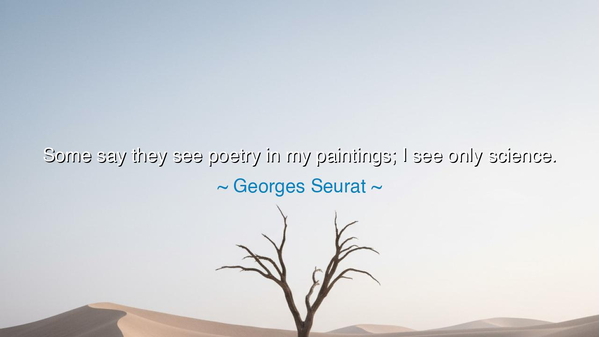
Some say they see poetry in my paintings; I see only science.






Listen, O children of the future, for the words of Georges Seurat speak of a truth that bridges the realms of art and science, a truth that resonates with the very soul of creation. "Some say they see poetry in my paintings; I see only science." With these words, Seurat reveals the hidden foundation of his art—not a mere expression of emotion or beauty, but a disciplined study of the very principles that govern how we perceive the world. In his paintings, Seurat did not merely paint what he saw with his eyes; he sought to understand how light, color, and form could be broken down into their scientific elements, to be reassembled into something new, something more powerful. For him, there was no division between art and science—they were two sides of the same coin, both driven by the quest to understand the world and express that understanding.
Let us think upon the ancient philosophers, O children, who also saw the world not as a collection of disconnected fragments, but as an intricate web of patterns and laws. Consider the great Pythagoras, whose understanding of mathematics and harmony in music was inseparable from his views on the cosmos. For Pythagoras, the universe itself was a reflection of mathematical principles—a symphony of numbers, ratios, and proportions. In the same way, Seurat’s art was not merely a visual expression, but a precise and calculated study of color and light—a study that sought to reveal the science behind the beauty of the world. Through pointillism, his technique of applying tiny dots of color to the canvas, Seurat revealed the scientific underpinnings of vision, how the eye blends the colors together to form a cohesive whole. To him, his paintings were not works of mere inspiration, but of reason and observation.
Consider, too, the great Leonardo da Vinci, whose work as an artist was inseparable from his studies in anatomy, engineering, and physics. Da Vinci did not see his art as separate from science—in fact, it was through his scientific observations that his masterpieces, such as the Vitruvian Man and The Last Supper, took form. For da Vinci, the human body was not just a subject for art, but a puzzle to be solved. The precision of his drawings was a reflection of his desire to understand the scientific principles that underlie life itself. Just as Seurat saw science in his paintings, so too did da Vinci see art in his scientific studies. Both men were driven by the same curiosity, the same need to explore the world, not just for beauty, but for understanding.
Seurat’s statement, O children, calls us to consider the relationship between creativity and science. We often see these two pursuits as distinct, one fueled by inspiration, the other by reason. But Seurat reminds us that the true artist, the true scientist, is one who seeks to understand the laws of the universe, to break down the elements of life into their smallest parts, and to reassemble them into something new and meaningful. The poetry that others see in Seurat’s paintings is not an abstract, disconnected beauty—it is the result of a deeply scientific approach to color and form. In his work, Seurat sought to understand the science of perception, how the eye receives light and mixes colors. What others call poetry, Seurat calls reason—a reason that is as beautiful as it is structured.
Consider also the example of Marie Curie, whose discovery of radioactivity forever changed our understanding of the physical world. Like Seurat, Curie was not satisfied with surface-level explanations. She sought to break down the very substance of matter into its fundamental particles, to understand how the world works at its core. And just as Seurat’s pointillism revealed the underlying patterns of color and light, Curie’s research revealed the unseen forces that govern the atom. Both Curie and Seurat were not simply creators in their respective fields, but seekers of truth—truth that is not always visible on the surface, but can be uncovered through the disciplined application of science and inquiry.
Thus, O children, the lesson is clear: art and science are not opposing forces. They are two ways of seeking to understand the same universe. Seurat’s vision teaches us that creativity is not just about expressing emotion, but about seeking to understand the underlying laws that govern the world. In his paintings, he saw the science of perception, the mathematics of color, and the physics of light. The true artist and the true scientist both seek to uncover the hidden forces that shape our reality, to break down the world into its component parts, and to reassemble them into something new, something beautiful, something that reveals the deeper truths of existence.
Let us, therefore, follow in the footsteps of Seurat and those like him. Let us not be content with surface-level understanding, but strive to uncover the deeper patterns and principles that shape our world. Whether you are an artist, a scientist, or a philosopher, remember that the pursuit of knowledge is the pursuit of understanding. And in that understanding, you will find not only the answers to life’s mysteries, but the beauty that lies within those answers. As Seurat shows us, when art and science come together, they reveal a world that is as structured as it is beautiful, a world where reason and creativity are not opposites, but partners in the great dance of discovery.






AAdministratorAdministrator
Welcome, honored guests. Please leave a comment, we will respond soon